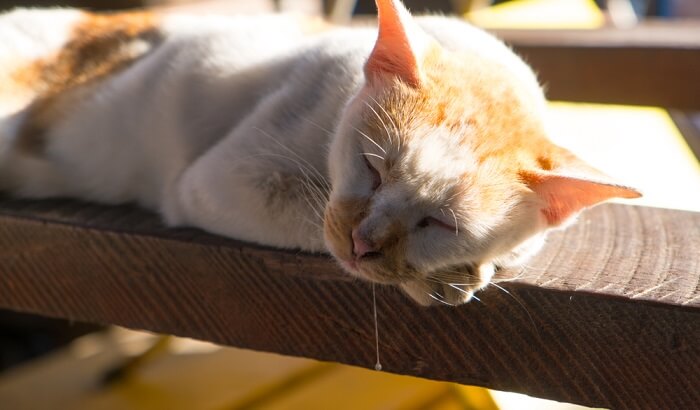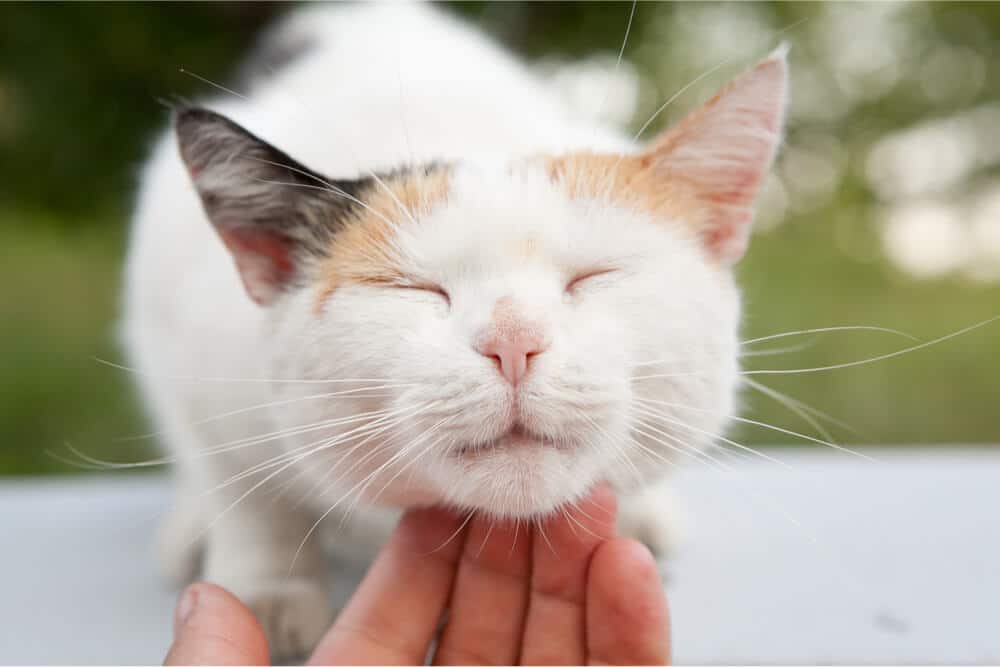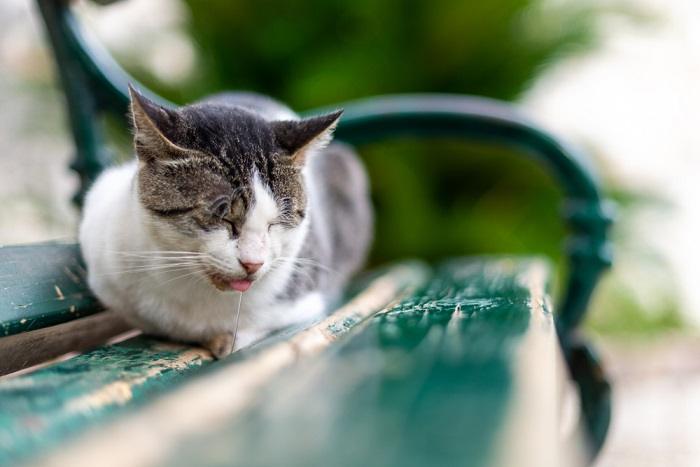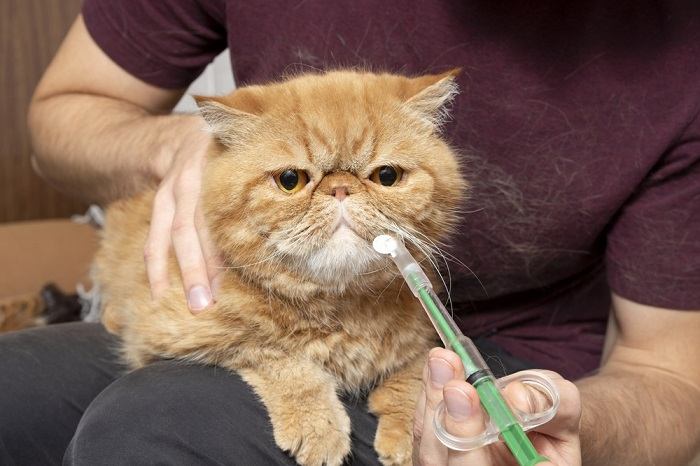Levetiracetam, or Keppra, is an anticonvulsant medication that is used in cats to help manage seizure disorders. In this article, we’ll explore how levetiracetam for cats works, when it is used, adverse effects to watch out for, and some frequently asked questions.
Levetiracetam for Cats Overview

About Levetiracetam for Cats
Drooling and losing consciousness are two symptoms associated with seizures.
Levetiracetam, or Keppra, is classified simply as an anticonvulsant. An anticonvulsant like Keppra is an antiseizure medication that may be used in veterinary medicine in a variety of cases where a seizure disorder of some kind is present in cats.
A seizure occurs when a sudden discharge of electrical signals occurs in the brain that leads to involuntary activity in the body, or seizing. Patients experiencing a seizure often lose consciousness and the body may then exhibit muscle spasms and convulsions. In some cases, the person or pet seizing may go completely rigid with stiff muscles. Drooling, urination, and defecation may also occur.
Seizures can occur for a variety of reasons. The presence of brain tumors and inflammatory lesions in the brain can be one set of causes. Cats may also develop seizures from certain underlying medical disorders like liver and kidney disease, toxin ingestion, or if a diabetic’s blood sugar goes too low.
Seizures can also occur secondary to a condition known as idiopathic epilepsy. With epilepsy, neurologic overexcitement occurs, leading to a seizure, but with no known cause. Cats with epilepsy often have normal MRI (magnetic resonance imaging) scans of the brain.
As an anticonvulsant medication, Levetiracetam helps to treat seizures by reducing the abnormal electrical activity that leads to seizure episodes. There are several types of antiseizure medications available. Each one works in a different way and some are more effective in than others.
Also Read: What Can You Give A Cat For Pain? 6 Vet-Recommended Options
Keppra’s mechanism of action to prevent seizures is not fully understood. It appears to affect the release of neurotransmitters in the central nervous system (CNS) by selectively binding to certain proteins on nerve synapses. It then prevents the organization or synchronizing of electrical signals that cause seizures, as well as the propagation or spread of seizure activity.
While stopping this overexcitement of electrical stimulation in the brain, Keppra does not affect the normal excitement of neurons required for normal function.
What Does Levetiracetam Do?
Levetiracetam for cats may be used as an add-on anticonvulsant when a primary drug, like phenobarbital, is failing as a sole therapy. Because phenobarbital can have more profound side effects, levetiracetam may also be used in its place if a cat is unable to tolerate phenobarbital.
Phenobarbital tends to have more profound side effects. In addition, there is a need to check blood concentration levels and liver function. Because of this, some veterinarians may elect to start a cat on levetiracetam primarily as a monotherapy.
Levetiracetam tends to be more expensive than phenobarbital, but tolerance tends to be good with lower side effects than some other anticonvulsant drugs.
Also Read: Cat Bloodwork (Different Types of Tests, Health Conditions And Costs)
A disadvantage to levetiracetam for cats is that the immediate-release form of the drug must be given every 8 hours, or three times a day. There is an extended-release form which in cats can be given just once daily, but it is more expensive than the regular Keppra.
Side Effects of Levetiracetam for Cats
While levetiracetam is toleraterd well in cats, drooling and lethargy are some common side effects of it.
Levetiracetam is generally tolerated very well by cats. The most common adverse effects include reduced appetite, excessive drooling, lethargy, and ataxia (poor balance when walking). These effects may only occur briefly.
For cats with kidney disease, Keppra should be used carefully. While not documented in cats, evidence has been seen in humans that clearance of levetiracetam by the kidneys is greatly reduced. A higher incidence of side effects has been seen in dogs with chronic kidney disease (CKD).
Also Read: What’s The Best Food For Cats With Kidney Disease?
The presence of CKD may only necessitate the reduction of dose or frequency versus fully discontinuing the medication. This is especially true if seizure control is being achieved.
If you are ever concerned that your kitty may have developed side effects while using levetiracetam (Keppra), make sure to contact your veterinarian, the ASPCA Animal Poison Control Center (1-888-426-4435), or Pet Poison Helpline (1-855-764-7661) immediately for further advice.
Also Read: Poisoning In Cats: Causes, Symptoms, and Treatment
Levetiracetam Dosage for Cats
Dosing levetiracetam for cats is complicated and should be done with the guidance of a veterinarian.
Levetiracetam is not FDA-approved for use in cats. However, it has been used successfully to control seizures in cats, depending on their underlying cause.
The starting dose suggested for Keppra is 20 milligrams per kilogram. For immediate release, Keppra must be given every 8 hours, or three times a day. Using it less frequently often results in poor seizure control. There is also an oral solution that is dosed at the same frequency as the standard tablets.
For the extended-release levetiracetam tablets (Keppra XR), the suggested dose is one of the 500mg tablets once a day.
Keppra has a high therapeutic threshold, but dosage adjustments should be made cautiously with any medication. Cats may still have refractory seizures even while on anticonvulsant medication. Discuss with your veterinarian what frequency is considered acceptable for your cat.
It is very important to discuss Keppra dosing with your vet. This is especially true in cases where additional doses may be given in the event of a seizure and the highest maximum dose that may be considered. It is always important to make any medication adjustments with the guidance of a veterinarian.
Also Read: The 7 Best Supplements For Cat Urinary Health
Conclusion
Levetiracetam is considered a safe and effective anticonvulsant medication for cats.
Although Keppra is considered to have a very high therapeutic level of safety, it is important to always discuss dosage with your veterinarian.
Drug Dosing Disclaimer: We are only able to provide doses for medications that are FDA approved for use in cats and only as the label guidelines dictate. For medications that are used off-label we can only provide guidelines and safety information for use. Safe and appropriate dosing for off-label medications can only be determined by a primary care veterinarian.
We encourage you to work with your veterinarian to determine if a particular medication is appropriate for your cat. Changing or adjusting a dose for your cat on your own without consulting with a veterinarian can carry risk. We do not encourage use of medications prescribed for human use in pets without first consulting with a primary care veterinarian.
Frequently Asked Questions
How long does levetiracetam take to work in cats?
In cats, the bioavailability of levetiracetam is nearly 100% for the immediate-release form. This means that nearly all of it is absorbed after oral administration. While data is not specifically available for cats, in dogs levetiracetam reaches peak concentrations between 30 minutes and 2 hours.
Is levetiracetam safe for cats?
Levetiracetam is considered very safe for cats. The most common side effects include reduced appetite, balance issues when walking (ataxia), drooling, and lethargy. All of these effects may be transient and subside over time.
Even in the case of overdoses, significant toxicity is not typically seen, though professional help should still be sought in these cases.
How long does it take for antiseizure medication to work in cats?
The time it takes for an anticonvulsant to work varies a lot depending on the type of medication and its role.
In the case of an active seizure, only certain drugs are used to stop one. These include Valium (diazepam) or midazolam. These drugs are most often given at veterinary hospitals, but sometimes may be formulated to give at home.
Most oral anticonvulsant medications are not used to actively stop seizures. Their role is to desensitize the brain to the signals that lead to seizure activity over time. The hope is they will prevent seizure episodes before they start. In this role, Keppra likely has one of the shortest onsets of action to reach peak levels in the body, which can occur in as little as 30 minutes after ingestion, up to about 2 hours.
Phenobarbital by contrast may take anywhere from 4-12 hours to reach peak levels. Zonisamide, another anticonvulsant, has an onset of action of about 4 hours.
For these drugs to help prevent seizures, they must be given continuously as directed. The frequency for them may vary depending on the type of medication and how it is absorbed and cleared by the body.













